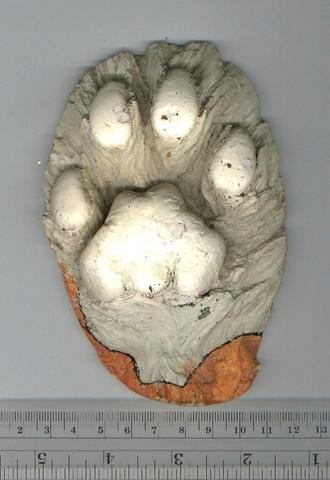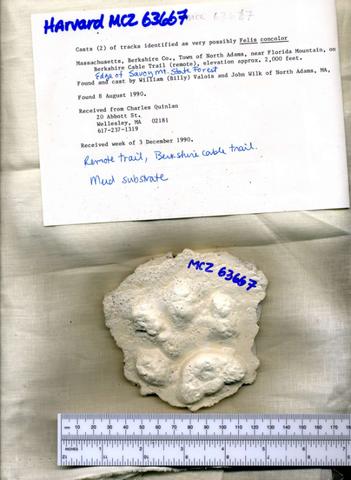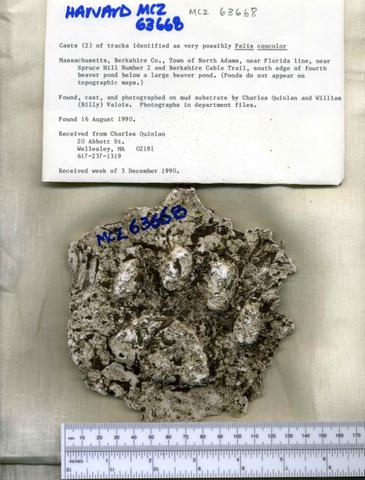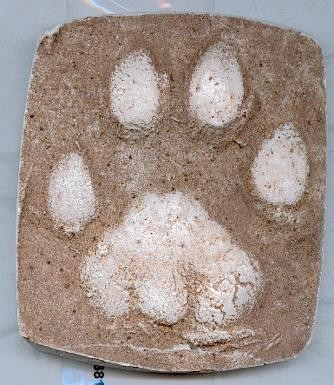Berkshire Beast Blarney?
Posted by: Loren Coleman on February 2nd, 2007

A copy (above) of an allegedly actual mountain lion (puma, cougar) track sold commercially by Acorn Products.
As you may recall, in the recent posting entitled “Eastern Cougar Catfights”, I discussed the on-going battles between the older pro-eastern felid group, Eastern Puma Research Network (EPRN), and the newer more debunking Eastern Cougar Foundation (ECF).
ECF member and mushroom expert Joseph Lankalis has “demanded” that I publish his contribution below, before it goes up on the eastern cougar page. To demonstrate how personal this feud has become, sure, I’ll post this. Lankalis’ argument may have some merit but the way he delivers his case is troubling and merely reinforces what I have said previously here about trouble in the puma country.
Another look inside the feud between cougar organizations reveals more hostility, in spite of the fact there may or may not be evidence for a hoax taking place. Sometimes the acidic comments can be directed to anyone that questions what is occurring – from either side. Please note, I am not a member of any puma, eastern cougar, or felid organization.
Lankalis says my original posting was “outrageously absurd,” and then follows up with: “I know you are a fair man and will post this on your cryptomundo to make things right. If you don’t, then that will tell me about the real you. These people [ECF members cc’ed his emails] are my witnesses.”
When I requested that he cease with the negative energy emails, he responded: “It is clear that you are an enemy to be avoided.”
Lankalis recently admitted it was not Helen McGinnis but he who is behind the “hoax” project. He feels his insights about the Bershire casts should be compared to how people now know that the following are hoaxes: “Piltdown Man, Nessy [sic], Panthera atrox [sic], and mysterious cats [sic].”
Mr. Lankalis has it all figured out and he is always ready to let everyone know he has the final word. He may be correct about the Berkshire situation, but his blanket statements regarding the discovery of a hoax or some mistakes equals the overturning of all the evidence of cryptid felids in the East only goes to demonstrate the shortsightedness of his global debunking approach.
To refresh your imagery memory and to key the following casts to the discussion that follows, please note these photos. Carefully see that #11 is used twice by Lankalis, once for his “hoax” labeled cast and the other from an allegedly known puma track.

On display at Harvard’s Museum of Comparative Zoology: The Harvard verified casts (above and directly below) of credible eastern cougar tracks found in Massachusetts in 1990. The above cast is labeled in ECF’s Hoax file as #11, the other below, ECF’s Hoax file #12 Hoax file.


The above (allegedly authentic) cast is ECF’s Track file #11.
What follows is Lankalis exposé (unedited).
^^^^^^^^^^^^^^^^^^^^^^^^^^
The Virtue of the Berkshire Casts.
In 1990, two naturalists from Massachusetts turned in two plaster casts of cougar tracks to the Museum of Comparative Zoology at Harvard. These casts were submitted as evidence of the presence of cougars in the Berkshire Mountains. Recently, these tracks were declared bogus. Even more recently that declaration was further declared unjustified and slanderous to the reputations of the two naturalists. The denouncements of the Berkshire tracks were not made without substantiation. I will explain why those tracks are bogus in this post.
I do not mention the names of the naturalists because the exact nature of the tracks’ origins is not completely understood. Did some unknown person(s) give these tracks to the naturalists, or did the naturalists fabricate them themselves. Only an honest dialogue with the naturalists will determine that. This post will not explore the origins of these track casts.
These casts were on display at the second Eastern Cougar Conference at Morgantown in 2004. There were many qualified track experts who saw them. At the time, my own experience was still too limited.
I can explain their validity by abnormalities of morphology and anatomy. I am quite certain that these tracks were man made and not misidentifications. If someone is going to make tracks by hand, he had better have a good understanding of anatomy and bone structure. A blatant error was included in the construction of these tracks. Look at them carefully. Are they right or left? True cat tracks are asymmetrical and easily distinguishable right from left. The hoaxer forgot or did not know about this.
The feet are composed of the following bones: phalanges, metacarpals, metatarsals, carpals, and tarsals. Since cats are digitigrade (walk on toes), only the distal ends of the metacarpals and metatarsals shape the track. In plantigrade animals, the entire lengths of these bones shape the tracks. The phalanges are the toe bones. The metacarpals and metatarsals form the heel pads of the front and hind feet respectively. The carpals and tarsals form the wrist and ankle bones.
The Berkshire tracks are listed as #11 and #12 in the Hoax section of the photo album. Compare them to #11 in the Tracks section. The contrasts are obviously different. Right and left are ambiguous. These bones are connected end-to-end to each other. The first phalanx connects to the second phalanx connects to the third phalanx which finally connects to the distal end of the respective metacarpal (if it is the front foot).
Notice how the lateral toes of #12 appear to be disjunct, i.e., they appear not connected to the foot. That is because the phalanges are not in a straight line with the distal end of the metacarpal. Whether it is your own hand or any other animal’s paw, the phalanges are supposed to line up in a straight line in the normal appendage. Failure to include this fact by the fabricator is a major error in anatomy. That is why the #12 is bogus.
The #11 track has the toes properly radiating away from the distal ends of the metacarpals, but the fabricator made a mistake in morphology.
Again, you cannot distinguish between right and left. Also, the toes are too large, too long, and not the proper shape. In the genuine cattrack 4TH. This an abbreviated way of saying, in a cattrack the combined area of the toe pads is less than the area of the heel pad. For dogs, it is the opposite. The #11 track is way off on proportions. Both tracks are erroneous in the exact shape of the heel pads. See #11 in the Tracks section.
I believe I have made my points quite clear as to why the Berkshire Tracks are bogus. I always try to avoid conjecture.J.A.LANKALIS
The catfight continues, as seen in yet another look inside the feud between cougar organizations. What is revealed is merely more hostilities. The reality or hoaxing of information and evidence seems hardly important in this environment where civility takes a backseat to the cult of personality.
About Loren Coleman
Loren Coleman is one of the world’s leading cryptozoologists, some say “the” leading living cryptozoologist. Certainly, he is acknowledged as the current living American researcher and writer who has most popularized cryptozoology in the late 20th and early 21st centuries.
Starting his fieldwork and investigations in 1960, after traveling and trekking extensively in pursuit of cryptozoological mysteries, Coleman began writing to share his experiences in 1969. An honorary member of Ivan T. Sanderson’s Society for the Investigation of the Unexplained in the 1970s, Coleman has been bestowed with similar honorary memberships of the North Idaho College Cryptozoology Club in 1983, and in subsequent years, that of the British Columbia Scientific Cryptozoology Club, CryptoSafari International, and other international organizations. He was also a Life Member and Benefactor of the International Society of Cryptozoology (now-defunct).
Loren Coleman’s daily blog, as a member of the Cryptomundo Team, served as an ongoing avenue of communication for the ever-growing body of cryptozoo news from 2005 through 2013. He returned as an infrequent contributor beginning Halloween week of 2015.
Coleman is the founder in 2003, and current director of the International Cryptozoology Museum in Portland, Maine.










I don’t really understand all the “bone” talk. I’ve seen domestic cat prints my whole life. Ones in the snow, Muddy tracks up and down and across a car, in the sand, in the mud etc. They always had the pad and toes in the print.
What so special about a big cat not leaving the same type of print?
I went out just a few moments ago to check the Tabby prints in the snow. I couldn’t tell which was the right or left except by seeing the direction of the tracks.
I have a small dog. The difference in their tracks were the cat’s had no claw marks because he retracts his claws when he walks.
I’ve noticed that Bears and wolves and coyotes all leave claw marks too.
What do I know? I’m just a common folk from Indiana.
I hope that everyone who sends money to these two organizations sees these articles so that they will see what their money is REALLY supporting.
I’d like to know how exactly this little feud is furthering eastern Puma research?
Jeez, and all this debating and argueing over an animal that is KNOWN to exist. Even debates over the existence of Bigfoot don’t always get this heated!
C’mon, folks ~ aren’t there cougars in captivity somewhere? Can’t SOMEBODY produce some decently detailed, unambiguous prints and castings from a known animal to be utilized as a comparative standard?
Acting like a bunch of juveniles… grumble… mumble…
Ah, the dark side of human nature rears it’s ugly head again.
This kind of Juvenile stuff happens everywhere.
Who’s to say that there ISN’T still a small population of cougars in the Eastern U.S.? The Florida Panther (cougar) is still hanging on by the slick of its teeth and the tips of its claws. So why COULDN’T a small population of cougars still survive in the wilder areas of the East? There is a place near me here in northwest Georgia called Fort Mountain State Park. The whole place is set up to be bear proof. Why? because there are loads of black bears there (which is why our Cub Scout Pack vetoed it as the place to do our end-of year campout). Why couldn’t cougars be there – or even in the even more remote areas of the Chattahoochee National Forest? I’d LOVE to see Red Wolves reintroduced here.
A cougar could walk the length of the Berkshires two, maybe three days.The cats can travel 200 miles in a week. One cat could travel all over the Northeast in a summer, just like the bears that travel the length of Kentucky and Tennessee every summer from the Smokies. THERE ARE WILD PUMAS IN THE EASTERN U.S. What’s the big deal !!!! There are bears, moose, wolverines, bobcats, foxes, coyotes and even armadillos traveling all over the place.
These folks have got too much of their egos invested in this. When a puma is run over by a fan leaving Foxboro stadium, it will be an interesting news item, but Ho-hum, it’s not going to win anyone a Nobel prize.
I have do doubt that eastern pumas exist and that they have always been here, albeit in very low numbers. They were almost wiped out by the late 19th/early 20th century in most places, but there are places along the Appalachians, in the Ozarks, and in the swamp regions near the Gulf that are as wild today as they were a thousand years ago, and those places have their resident populations of pumas – which are now increasing again.
There is plenty of cover and game in the eastern US. That means there’s a lot of vacant puma territory in the east – plenty of room for dispersing young adults. Therefore I don’t think that there will be a major problem with puma attacks on people in the East, at least not for awhile, because young cats can easily find game. The whole place is swarming with deer, groundhogs, and rabbits. Some areas such as eastern Kentucky have elk herds now and there are lots of wild pigs too, especially in the South. The odd cat here or there may jump a human, and those attacks make international headlines, but there are many documented instances of pumas following people for miles, apparently out of curiosity.
All the same, I am careful in the woods. The woods here are lovely and exuberant, mostly hardwoods like beech and “poplar” (tulip tree), interspersed with large swaths of pine and hemlock. They grow right down to the yards and roads. I’ve had coyotes snatch well-loved cats from the backyard while I gathered flowerpots from the front yard, in broad daylight in the middle of summer. The forests are beautiful and I have run these hills all my life, but I no longer go out into the woods alone. I love cats and I am glad that pumas are repopulating the East. Maybe they’ll eat some of the coyotes! But pumas are big, potentially dangerous predators, so developing the habits of caution and awareness in the woods is just good common sense.
It disgusts me that people who purport to be investigating eastern puma activity would fall to such childish infighting as this. It’s going to take volunteers, lots of volunteers – OBJECTIVE volunteers – to gather the evidence needed to prove the existence of pumas in the East. When these people begin to think they are the sole authorities on the subject their hubris gets in the way of their research.”Official” wildlife agents are spread too thin, and too busy with their other activities, to chase after will-o’the-wisps like pumas that don’t “officially” exist.
Puma tacks vary in size and shape due not only to differences in the cats themselves, but also due to such things as scars and injuries, as well as differences in the terrain where the tracks are found. Sure, some people probably make fake prints. But that doesn’t mean that all the tracks are faked. With a good, clear cat track made under favorable circumstances, a very experienced observer can sometimes tell whether it was a right paw or left paw. So what? Most cats do have two of each. And most prints are not made by pressing a tame captive puma’s paw into clay, but by living animals walking over natural surfaces, shifting their weight as they go. It would be convenient if wild pumas always placed their paws just so, to give the researcher nice clear textbook prints to study. But that’s not the way it works in the real world. Tracks vary.
I’m no expert on these things by a long way but just to note that ‘Hoax’ #11 is asymmetrical and that if the toes prints on the real track were not painted they’d look at bit larger than they do.
Egos gone mad!